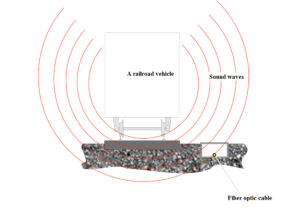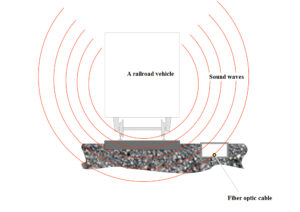 The principle of distributed acoustic sensing (DAS) operation is based on the processes occurring in fiber optic cables. To be more precise, sound waves falling at the fiber cable change the reflection of laser beam pulses inside it. Thus, these changes are possible to be detected.
The principle of distributed acoustic sensing (DAS) operation is based on the processes occurring in fiber optic cables. To be more precise, sound waves falling at the fiber cable change the reflection of laser beam pulses inside it. Thus, these changes are possible to be detected.
Specially developed algorithms allow converting a measurable backscatter signal trace (signature) into valuable information, for example, about moving rolling stock, about people moving along or near tracks, or other actions, such as earthmoving operations.
A common application of acoustic sensors
The application of DAS-based systems becomes widespread, for instance, in the oil and gas industry, as well as in the border protection due to these technical capabilities.
Any single-mode fiber can be quickly and easily converted into a series of “virtual microphones” by distributed acoustic sensing. This requires only minimal exposure to the ends of the optical fibers.
Railway application of DAS
Since the majority of railway tracks already have fiber optic cables, the above-mentioned possibilities of DAS application in the railway infrastructure can be performed to a large extent using existing resources.
If an existing fiber optic cable already laid close to the railway infrastructure is used, it is possible to monitor trains, auxiliary rolling stock, track crews, strangers near tracks, or natural influences on the infrastructure.
Accordingly, DAS technology can find application in tracking systems for the movement of trains, monitoring the track and rolling stock, as well as in the protection of railway infrastructure.
Only one set of DAS systems enables to monitor processes and components on and off track for 40 km. It is possible to combine many such units into a common sensing system to cover extensive networks of railway tracks. At the same time, the DAS system operates with an accuracy of 10 m and provides information about the location of the recorded event on the site and GPS coordinates.
Opportunities in acoustic sensing
Several acoustic sensing sets can be combined into a single system to control longer tracks. The possibilities of the co-use of distributed acoustic sensing and wheel hole registration systems were already studied to meet the requirements of the railroads, taking into account the considered limitations.
The application of advanced axis counters is caused by the need to detect individual axes and the train location on a particular track in compliance with safety conditions.
Unlike track circuits, directly establishing the free or occupation part of the track, the axis counting system operates indirectly. If the track part was free in the initial period, and then the number of wheelsets entering and leaving coincided, the part is registered as free from railroad rolling stock. If this condition is not fulfilled, the part is considered occupied.
The data combination from both sensing systems creates a whole variety of new possibilities by using the generated information from fiber optic acoustic sensors. This technical solution of acoustic sensing makes it possible to detect a train to a concrete track precisely.
Also, DAS technology provides an even more accurate determination of the train length. Moreover, this combination of sensing systems offers the opportunity to localize events, for example, you can determine which axis has a slider. In this combination, DAS can also be used on sections of railway tracks with complex track development, where several parallel tracks are connected by operations.
The user interface system of distributed acoustic sensing displays in a convenient form both data received directly from the DAS system and information generated using combined technical solutions, including additional axis counters and a system for registering the wheel hole of railroad rolling stock.
Conditions detected by the DAS system and a combined technical solution are carefully classified and all received information is provided in a visual form. This serves as the basis for the planning and implementation of activities arising from the detection results.
Besides, the data collected by distributed acoustic sensing can be redirected directly to mobile end-user devices. Nevertheless, they can also be transmitted, for example, to unmanned aerial vehicles, which are sent to the appropriate location using available GPS data. Thus, the DAS system allows you to quickly respond to a variety of events.
The interference of both signals will make it possible to more accurately correlate information about the state of train components with a specific location in the future, for example, it will be easy to establish which axis has the slider on it. New possibilities are opened up for using DAS technology in complex railway tracks, where several parallel tracks are connected by operations.
Abilities presented by DAS systems
The system of distributed acoustic sensing allows both monitorings of rolling stock and state track components: the DAS system completely controls the railways and the area around them. Even unforeseen events that are difficult to detect are recognized reliably.
This also applies to fractures of rails, which represent one of the main risks on the railway. This sensing system also detects electrical discharges on air-track lines due to overload, floods, stone falling, falling of trees, and mudflows. Fiber optic acoustic sensors can significantly reduce the number of costly violations of the usual operation in railway transport.
With an increase in the accuracy of event localization, conditions are created for the application of DAS technology in areas with complex track development.
The signals (signatures) recorded during the movement of trains by the axis counters and the acoustic sensors are brought together to determine the exact location.
Parameters provided by acoustic technology
The possibilities of using acoustic sensing technology in railways open up broad prospects for increasing the effectiveness of monitoring infrastructure and rolling stock. Thus, the DAS system provides structural health monitoring information about:
– location of the train;
– direction of the traffic;
– speed;
– time of train arrival;
– the distance between trains;
– rail break;
– slide;
– falling of stones;
– spark discharge in the contact network;
– unauthorized access;
– cable theft;
– vandalism, etc.
Data obtained by axis counters
Axis counters provide information about:
– the state of free/occupation of a track particular section;
– number of axes on the track section;
– speed;
– direction of the traffic;
– diagnostics.
Level of safety and security
An important aspect of railway operation is safety. Security has many indications and affects numerous different areas. DAS provides a comprehensive solution to cope with several tasks – from labor protections to the protection against vandalism.
Distributed acoustic sensing offers railway operators a single solution for the protection of infrastructure and the safety of railway workers, with an extended range and high efficiency.
DAS converts measured signals (signatures) into valuable information, for example, about moving vehicles and individuals. Based on this information, messages are generated about the presence of objects or people, which can be more accurately classified due to the high sensitivity of the sensing system. It also allows for directly recognizing certain actions, for example, earthmoving on the way, and displaying the corresponding alarm messages.
Importance of acoustic sensing for railways
Finally, distributed acoustic sensing systems will change the way that trains are monitored and infrastructure is operated soon. An integrated railway structural health monitoring system is becoming available, which opens up previously unimaginable DAS applications and allows for the implementation of the most challenging ideas in the field of train and operation control.
The use of a distributed acoustic sensing systems for the railway industry opens up wide applications for monitoring the movement of trains, monitoring the condition of equipment, protecting infrastructure, and ensuring the safety of people in real-time.
Advantages of acoustic sensors
Moreover, recent advances in DAS make the sensing systems cost-effective, highly precise, herewith, these acoustic sensors do not require accurate alignment resulting in tuning vibration measurement to a particular point in the optical fiber. Thus, new DAS systems promote the speed of measurement beyond the previously established theoretical limit set by the sensing distance. The technology of new fiber optic acoustic sensors is based on the application of “colored” probe pulses or linear frequency multiplexing.
It should be noted that DAS is a highly reliable technology because it continues its operation even after it has been cut. DAS has the biggest influence in the signaling area, for example, distributed sensing helps to manage trains by control of their accurate position and motion in real-time. The technology enables to reduce journey times while increasing rail capacity and improving safety.
Of course, the distributed acoustic sensing system continues improving and the improvement will provide quantitative measurement with improved sensitivity and higher spatial resolution on longer lengths of the sensing fiber in the future.
How to find a professional manufacturer of acoustic sensing products?
Optromix is a DAS system manufacturer that provides top of the line distributed acoustic sensing systems suitable for monitoring of commerce networks. If you have any questions or would like to buy a DAS system, please contact us at info@optromix.com
 Nowadays scientists pay more attention to the process of Alpine microseismicity. The thing is that the sensing of seismic activity is important for studying landscape-shaping processes and predict dangerous mass movements. Nonetheless, the amount of modern fiber optic sensors is still low in Alpine regions. Therefore, distributed acoustic sensing (DAS) promotes solving the problem.
Nowadays scientists pay more attention to the process of Alpine microseismicity. The thing is that the sensing of seismic activity is important for studying landscape-shaping processes and predict dangerous mass movements. Nonetheless, the amount of modern fiber optic sensors is still low in Alpine regions. Therefore, distributed acoustic sensing (DAS) promotes solving the problem.

 The thing is that human hearing is actually limited. Nonetheless, the technology of
The thing is that human hearing is actually limited. Nonetheless, the technology of  The red palm weevil is regarded as a serious problem for the cultivation of date palms leading to massive economic losses worldwide. Although curative techniques are not challenging, early detection is still difficult to be performed.
The red palm weevil is regarded as a serious problem for the cultivation of date palms leading to massive economic losses worldwide. Although curative techniques are not challenging, early detection is still difficult to be performed.  A technique of noise suppression used f-x deconvolution and the wavelet transform allows reducing jump edges in the phase noise of
A technique of noise suppression used f-x deconvolution and the wavelet transform allows reducing jump edges in the phase noise of  A team of researchers from France proposes for the first time the opportunity to detect the propagation of seismic waves on the seafloor by
A team of researchers from France proposes for the first time the opportunity to detect the propagation of seismic waves on the seafloor by The principle of
The principle of  The operational principle of
The operational principle of  The
The  Distributed fiber optic sensing
Distributed fiber optic sensing Distributed acoustic sensing
Distributed acoustic sensing